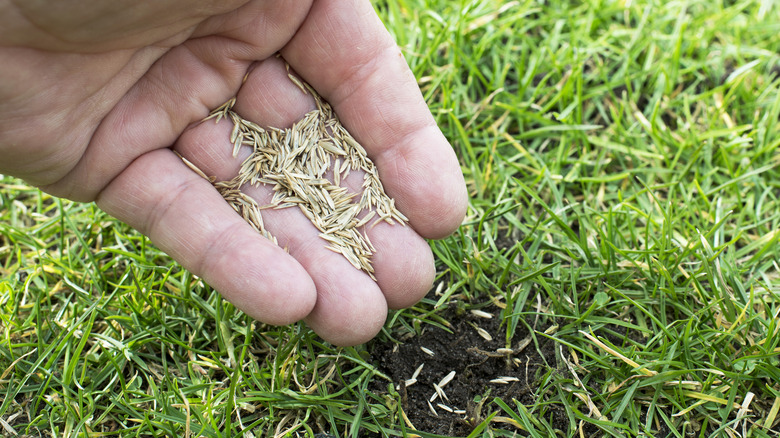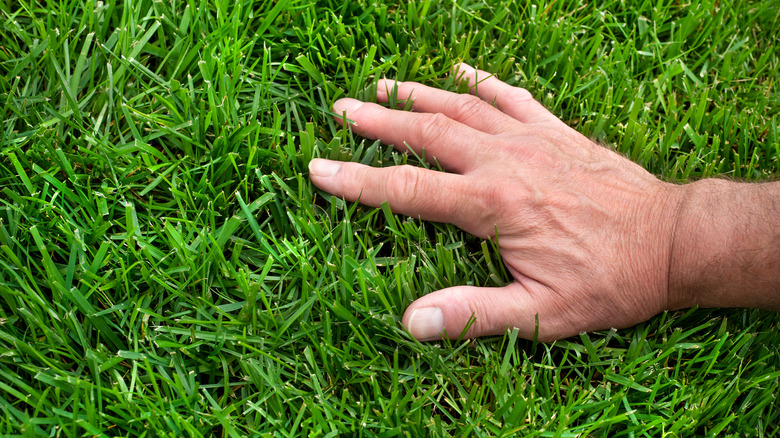Getting Grass Seed To Sprout This Spring Will Be A Breeze With TikTok's Handy Tip
Growing a lush green lawn can be surprisingly challenging. Simply scattering grass seed and hoping for the best almost ensures you'll be dealing with ugly patches of sparse coverage. The seeds may be washed away in a rainstorm, eaten by birds, or simply fail to sprout. Pre-germinating grass seed, a useful tip that's been making the rounds on TikTok, is one of the simplest and most effective ways to get your lawn off to a strong start.
There are a wide variety of different plants in the grass family (Poaceae) that are good options for lawns. Which is best for your specific lawn depends on your USDA zone and the amount of light your yard receives. While some grasses, like St. Augustinegrass (Stenotaphrum secundatum), require the warm climates of zone 7 and above, many others, including Kentucky bluegrass (Poa pratensis) grow best in cooler zones. Fescues (grasses in the Festuca genus) can grow in most of the continental United States and thrive during cool and humid weather. Unlike most other grasses that require full sun, many fescues are shade-tolerant and can grow in lower light conditions. Homeowners opt to use a mix of different types of perennial grasses, often in combination with annual ryegrass (Lolium multiflorum) to ensure a green lawn year-round.
How to pre-germinate grass seed
When scattered outdoors, grass seeds can take between 5 and 30 days to germinate, depending on the species and the weather conditions. Luckily, pre-germinating ensures the grass can get off to the best and fastest start possible and that the seeds are ready to start growing as soon as they are sowed. While there are a few variations on how to do this, they all require the seeds to be kept moist. Putting the grass seed inside a mesh bag in a large bucket with holes in the bottom and then putting that bucket into another bucket makes it easy to keep the seeds contained and provide them with fresh water. Simply fill your double bucket with water and after 12 hours lift out the top bucket of grass seed. The water can be dumped out of the bottom bucket, and then you're ready to put the buckets back together and refill with fresh water.
Once you see the beginnings of small white roots on the seeds, they're about to germinate, and you're ready to sow. Mix your seed with a carrier and fertilizer like Milorganite and spread the mix on your lawn using either a drop spreader or a rotary spreader. If you continue soaking your seeds past this point, they will be difficult to spread using a machine, and you may instead need to spread the grass seeds by hand.
Additional tips for a healthy grass lawn
While late summer or early fall is generally considered the best time to spread grass seed in most areas, spring is also a good option. Make sure at least the top 4 inches of our soil is well draining and loamy with a high amount of organic material. Add topsoil and other amendments as needed before spreading your grass seed, as soil health is an essential part of lawn health.
While pre-germination is one of the best options for ensuring your grass sprouts and begins growing quickly, your lawn care isn't finished when the seeds begin to sprout. Grass lawns can be surprisingly labor and resource-intensive when they're first getting established. To give your lawn the best chance to flourish, avoid walking on it as much as possible for the first several weeks after planting, and be prepared to water your lawn multiple times a day for the first month.

